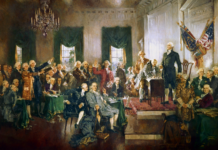The purpose of the new propaganda is to frame all the news in a way that aligns with the beliefs and attitudes of the chosen audience, so they can gain your acceptance for an agenda you would otherwise reject.
The further one ventures down the rabbit hole of propaganda, the harder it becomes to believe anything at all. America is an entertainment-addicted nation where the average adult spends at least five hours a day watching television. This means that most people come home from a hard day’s work and find relief by putting on the news, or any other program that entertains them in some way. Many people watch the news because it gives them a sense of staying up to date on important issues. There is little doubt that the politically active find entertainment value here as well, as the constant struggle between right and left-wing ideology is constantly portrayed. On either side, viewers are treated to several “talking head” pundits who define what issues should be considered important and why, while also providing comic relief by calling the opposing party brain dead. Americans, by and large, believe what they are viewing is an accurate depiction of what takes place in their nation. They remain trapped in a worldview that is defined for them through the news they expose themselves to. It is political conditioning of sorts, meant to, as Meerloo states in Rape of the Mind, “mold man’s mind so that its comprehension is confined to a narrow, totalitarian concept of the world” (p.22). This means that the programming available through mainstream media is geared towards guiding public thought towards the desired end or keeping it confined in a box useful to a tyrant’s purpose. This is a sentiment echoed in Edward Bernays’s Propaganda, where he says it is now possible to mold the minds of the masses so that they will direct all of their efforts towards the desired ends (p.19) of the shadow government, who use the powers of propaganda to gain approval from the people on issues they may have, at one time, disapproved of.
According to the book, The Manufacture of Consent: The Political Economy of the Mass Media, the networks Americans expose themselves to “propagandize on the behalf of the powerful societal interests that control and finance them” (p. 12). It is no secret that a very small number of corporations control all media in America. As of now, there are roughly two-dozen firms that have direct influence over what news Americans watch. The biggest being, of course, Disney, AOL Time-Warner, AT&T, and Viacom, just to name a few (p.14). These firms are more interested in selling products than they are in providing accurate news. Media revenues are generated through advertising, therefore, the more attention that can be brought to the products being advertised, the better the media outlet’s performance will be. This has motivated these large firms to focus more on entertainment than anything, for two reasons. One, of course, is revenue. The other – is because entertainment provides “an effective vehicle for hidden, ideological messages” (p. 20). A good example of this concept is the one provided in my article, Chinese Thought Reform and Modern Television Programming. In the show, Everybody Loves Raymond, Ray’s attitude towards his children’s desire to play fairies in a school play is guided towards correct thinking while the audience is entertained through the usual dose of insults, sarcasm, and circus routines. The hidden ideological message is the acceptance that liberal thinking is correct and conservative thinking is bigoted, buffoonish, and outdated. These types of messages dominate television programming, with most people being unaware of their presence. Another good example is the show, Ozark. As entertaining as it is, it does contain its fair share of propaganda. For example, the scene in season four where Wendy and her lawyer are trying to influence a Republican lawmaker to join their foundation, it is hinted that the Republicans were caught up in a scandal, producing voting machines that changed votes in real-time. The lawyer makes the comment to Wendy, who is a democrat, that “the machines will not be switching votes to her side of the aisle,” hinting that it is Republicans who manipulate elections.
In 1934, broadcasting rights were essentially given over to commercial interests, and according to Manufacture of Consent (p. 20), the public was never given the opportunity to voice their thoughts about it. This was about the same time that major revelations were being made concerning propaganda and persuasion, and how media broadcasts could influence public opinion. Interestingly, the FCC allegedly made a pledge to the public that the value of the news would never be undermined by the commercial interests that now control it. The news was not supposed to be driven by a need to produce revenue. This was a pledge, which according to Manufacture of Consent, went unfulfilled. The content is decided by the advertisers which fund the programming. The advertisers, in essence, provide the ads based on which content will drive most viewers to the program. The new propaganda, according to Bernays, picks apart the anatomy of society, its group formations, and loyalties. The book Brainwashing-A Synthesis of the Russian Textbook on Psychopolitics states that communists view individual men as an aggregation of cells belonging to a larger organism. This organism is the state. Bernays explains the propagandist’s view of society the same way. The individual is treated as merely a cell organized into a social unit (p. 28). The beliefs, habits, and mental clichés of the masses are taken advantage of and manipulated to the point where artificial reactions can be produced on demand, or meaningless stories can dominate the attention of the public. What does this have to do with the communist views of man?
In the article, Chinese Thought Reform and Modern Television Programming, I discussed a Chinese play called The Question of Thought, found in the book Brainwashing in Red China(p. 114). The play was meant to introduce communist ideas in a way that presented them as “correct thinking” through a medium that provided entertainment. This technique was refined to the point where propagandists in China were able to get the people to, as Edward Hunter states, “pull the wool over their own eyes and actually have fun doing it” (p. 211). Pro-communist messages were depicted in popular cartoons, providing a humorous means of instilling the communist line in thousands of official publications. According to Hunter, there was no opposition to this tactic that could expose it for what it was. He called it “the most brazen maneuver yet devised to deceive one’s own people” (p. 211). This technique was so effective it literally destroyed any belief that it could be propaganda at all, as it genuinely appeared to represent the beliefs of the cartoonists, and any number of the other cultural figures they were meant to influence. This achieved the desired result of a unified Chinese people, all rallying behind the communist cause.
In America, the technique has been further refined by keeping people trapped in the ideological box of their chosen political parties. Whether you watch Fox or CNN, you are bombarded with what they want you to think is important. The invasion of Ukraine is a case in point. While all eyes are fixated on the development of WWIII, little attention is being paid to the first 55,000 pages of data Pfizer was ordered to release to the public. Instead, the propagandists frame the issues they want the public to focus on, within the framework of the attitudes, beliefs, and opinions of the targeted audience. This is known as moral foundations theory. Framing issues from a particular viewpoint has shown that people are very susceptible to simple twists of words and reversing of logic. When stories are presented differently, it changes how people respond to them. Fox, for example, will work to frame the same story CNN is reporting from a conservative point of view. The trick in the whole technique, however, is the fact that both outlets are reporting the story to dictate what it is that Americans should consider being, important news. The twenty-four-hour-a-day news cycle, which continuously sensationalizes every story, is the entertainment medium that is one, bringing in the revenue for advertisers, and delivering the ideological messages meant to dominate public thinking.
If the Chinese could unify the entire country under one belief using propaganda cleverly hidden in cartoonish drawings, just think what “the deep state” can do when two dozen major corporations control nearly everything we see, hear and read in popular media today. They can, as Bernays states, “make the rest of us think what they please about any given subject” (p.31). They can make us like who they want us to like, and program us to react in ways they want us to react. It is hard to describe a solution for such a problem because most people don’t even know it exists. If you are an individual who likes to stay up to date on the news it is impossible to escape this. The most you can do is understand the method and the ideological aim behind it. The purpose of the new propaganda is to frame all the news in a way that aligns with the beliefs and attitudes of the chosen audience, so they can gain your acceptance for an agenda you would otherwise reject.
























